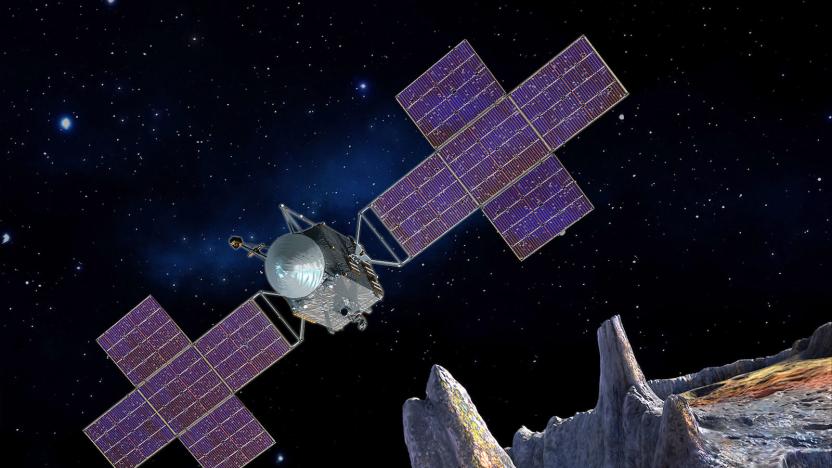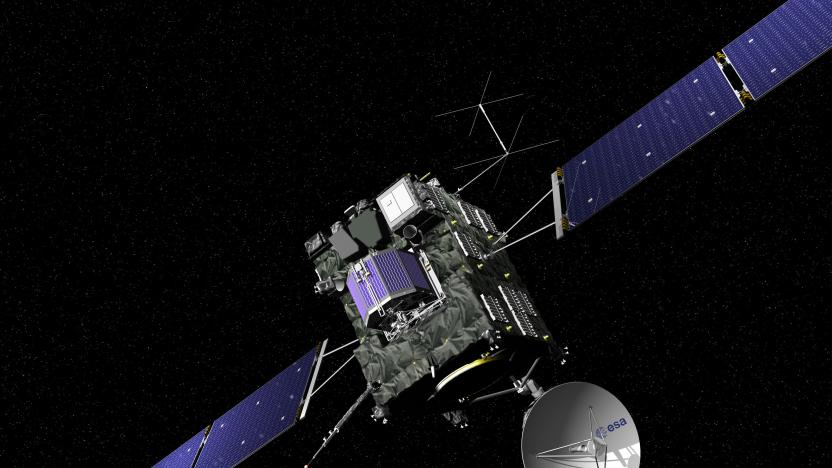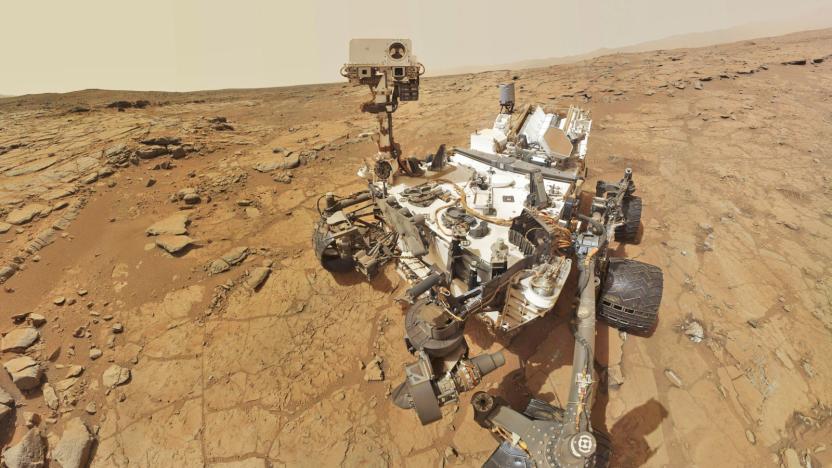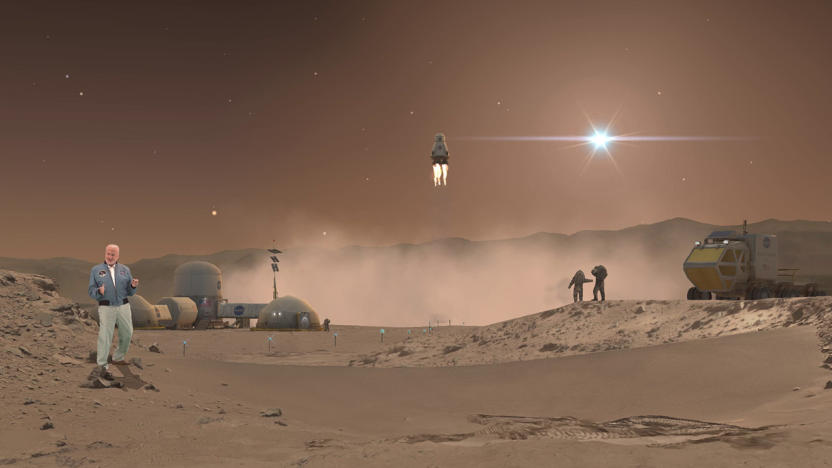nasajpl
Latest

Mars Opportunity rover will have 45 days to phone home
As a planet-wide dust storm enveloped Mars, many were concerned about the fate of the Opportunity rover. After all, Opportunity is dependent on solar panels; the opacity of the dust storm meant that she wasn't getting enough light to stay powered. The team at NASA's Jet Propulsion Laboratory last heard from Opportunity on June 10th. Now, the storm is lifting, and once its opacity reaches a tau level of 1.5, the little rover will have 45 days to respond to the team's signals. Otherwise, NASA will stop actively listening for the rover.

NASA probe on a fast track to reach metallic asteroid
While NASA's plans to put humans on Mars have suffered recent setbacks, its unmanned robotic programs are achieving milestones on a daily basis. Earlier this year, NASA announced that it had approved a mission, Psyche, to the asteroid belt. Today, the organization announced a shift in Psyche's launch schedule -- with big ramifications. Psyche 16 is a metal asteroid that may be the remnant of an early planet core. By studying the asteroid, scientists hope to learn more about Earth and the development of planets in our solar system. The mission was originally slated for liftoff in 2023, with arrival at the asteroid Psyche 6 in 2030. However, NASA directed the team to research whether an earlier mission would be feasible. After studying possible trajectories, they determined that launching one year early—in 2022—would shave four years off the spacecraft's journey. It's now expected to arrive at Psyche 6 in 2026.

ICYMI: DIY Iron Man
Today on In Case You Missed it: British inventor Richard Browning show us his (slow, careful) flights across a test area using his "Daedelus" jet pack prototype. Daedelus consists of six kerosene-powered microjets strapped to his limbs, which doesn't sound dangerous at all. While that might sound like a bad idea, the system "flies" at a walking pace, and the wearer only hovers about six to ten feet off the ground. For his part, Browning's convinced the jets are safe, stating that he uses small amounts of kerosene and has a dead-man's switch to kill the set-up when not pressed. For now, Browning is mostly shopping the device around at exhibitions, but he hopes it will one day be used by rescue or military personnel.

Rosetta probe's love affair with a comet ended predictably
Goodbye, Rosetta. After 12 years of getting up close and personal with Comet 67P, your service has come to an end. At approximately 7:19 am Eastern the spacecraft descended upon the comet one last time, snapping pictures and analyzing gases before crashing into its final resting place, according to NASA's Jet Propulsion Lab. Reuters reports that scientists in the control room clapped and hugged after screens indicated a loss of communication. Rosetta followed the comet around for over 6 billion kilometers since 2004. Shine on, you crazy diamond.

Curiosity rover can shoot lasers at any rock it wants
Is there anything cooler than sending a robot to Mars to shoot rocks with lasers? Probably not -- which is why NASA is giving the Curiosity rover the ability to shoot even more rocks with lasers. Okay, technically NASA is giving the Martian rover the ability to choose targets for ChemCam analysis. This is a process that uses a laser and telescopic camera to sort out the chemical composition of Martian rocks. Typically, NASA chooses the targets manually, but a new update will allow the rover to collect data autonomously.

Newly discovered asteroid is Earth's cosmic buddy
Earlier this year, the University of Hawaii's Institute for Astronomy and NASA's Planetary Defense Coordination Office spotted a new companion that follows the Earth on its yearly journey around the sun. According to the Center for Near-Earth Object Studies, the asteroid lovingly named "2016 HO3" is "too distant to be considered a true satellite, but it is the best and most stable example to date of a near-Earth companion, or 'quasi-satellite.'"

NASA's use of HoloLens puts you on Mars with Buzz Aldrin
I got a ticket to Mars. At the end of an exhibit hall at San Francisco's Moscone Center, a Microsoft representative punched my orange ticket. I was ready to strap on the company's augmented reality headset for a holographic stroll on the neighboring planet. I was one of eight HoloLens-wearing visitors in a group at NASA's Destination: Mars installation at Build. Although the demo was open to a limited audience last week, it will open its doors to all visitors at NASA's Kennedy Space Center in Florida this summer.

NASA patched Curiosity rover's autofocus problem over the air
Pardon me while I say something that might not be entirely popular: Software updates are pretty awesome. Maybe not so much for game consoles, but, I digress because the Curiosity rover recently received a patch that improved the autofocus of its "ChemCam" telescope. Over the air. On Mars. Before the update, scientists at Los Alamos National Laboratory would take nine pictures of a subject (each at a different focus) to get one usable close-up image of any of the Red Planet's rocks and soils, and send them back home. Same goes for any sample analyses the laser was doing. The problem is that for those analyses to be anywhere remotely useful, the telescope projecting said laser needs to be in focus and the workaround in place wasn't very efficient.

Surge the rescue robot is RoboSimian's more evolved sibling
It looks like the NASA Jet Propulsion Laboratory team responsible for RoboSimian's existence has been busy this year, creating its possible substitute for the DARPA Robotics Challenge finale. The result? A robot that stands upright at 4.5 feet and weighs in at 200 pounds called Surrogate, or Surge for short. It's more human-like than its predecessor, with its two arms, a head and a spine, which allows it to manipulate objects better. It also has Light Detection and Ranging (LiDAR) equipment on its head, which gives it the capability to create 3D maps of various locations using laser beams. Problem is, it can't climb rough or tall terrain, because it uses caterpillar tracks. Plus, its body only has room for one set of cameras.

NASA's JPL maneuvers a robot arm with Oculus Rift and Kinect 2, points to more immersive space missions
NASA's Jet Propulsion Laboratory has been on the hunt for a more natural way to maneuver robots in space for some time now, resulting in cool experiments like using a Leap Motion controller to remotely control a Mars rover and using an Oculus Rift plus a Virtuix Omni to take a virtual tour of the Red Planet. It therefore made sense for the folks at JPL to sign up for the latest Kinect for Windows developer program in order to get their hands on the newer and more precise Kinect 2 (which, incidentally, is not available as a standalone unit separate from the Xbox One) to see if it would offer yet another robotics solution. They received their dev kit in late November, and after a few days of tinkering, were able to hook up an Oculus Rift with the Kinect 2 in order to manipulate an off-the-shelf robotic arm. According to our interview with a group of JPL engineers, the combination of the Oculus's head-mounted display and the Kinect's motion sensors has resulted in "the most immersive interface" JPL has built to date. Join us after the break to see a video of this in action and find out just why one of them has called this build nothing short of revolutionary.

NASA JPL takes a VR tour of Mars with Oculus Rift and Virtuix Omni (video)
NASA's Jet Propulsion Laboratory likes to dip its feet in cutting edge consumer hardware from time to time, as evidenced by its trial use of the Leap Motion to remotely control a Mars rover. Well, you can't get much more cutting edge than virtual reality, which is why the team was so intrigued by the Oculus Rift when they first saw it at PAX last year. They signed up for a dev kit as soon as they could, cobbled the Rift together with a stereoscopic 360-degree panorama of Mars obtained from Curiosity, strapped on the VR goggles and found themselves magically transported to the Red planet. According to our interview with Human Interfaces Engineer Victor Luo, they then added terrain imagery captured from satellites so users could actually "walk" on Mars' rocky surface using an Xbox controller -- "with up to 25 centimeters per pixel." "However, we thought it'd be great if we could literally 'walk' on the terrain," said Luo. With that in mind, they contacted the people behind the Virtuix Omni treadmill. It so happens they were in the area for E3, so they brought the contraption up to JPL headquarters, hooked it up, and sure enough, they were able to "wander around" the surface of Mars with their own two feet. Join us after the break for more on our interview with Luo, plus a video clip of the aforementioned virtual Mars tour.

NASA JPL controls rover with Leap Motion, shows faith in consumer hardware (video)
If you think using the Leap Motion controller for playing air guitar and typing without a keyboard was cool, try using it to control a NASA rover. Victor Luo and Jeff Norris from NASA's Jet Propulsion Lab got on stage at the Game Developers Conference here in San Francisco to do just that with the ATHLETE (All-Terrain Hex-Limbed Extra-Terrestrial Explorer), which was located 383 miles away in Pasadena. As Luo waved his hand over the sensor, the robot moved in kind, reacting to the subtle movements of his fingers and wrists, wowing the crowd that watched it over a projected Google+ Hangout. We spoke with Luo and Norris after the panel to gain further insight into the project. As Luo explains, one of JPL's main goals is to build tools to control robots needed for space exploration. Seeing as the gaming industry is already rife with user-friendly controllers ripe for the plucking, it made sense to harness them for the job. "We're very used to the bleeding edge," he said. "From the Kinect to the PlayStation Move, they represent major investments into usability." Hit the jump for our impressions of the simulation software, a look at JPL's grander goal and for video clips of the demo and panel itself.

NASA's Curiosity rover finds ancient streambed on Mars, evidence of 'vigorous' water flow
Curiosity may have spent a while limbering up for the mission ahead, but now it's found evidence of an ancient streambed on Mars that once had "vigorous" water flow. Photos of two rock outcroppings taken by the rover's mast camera between the north rim of Gale Crater and the foot of Mount Sharp reveal gravel embedded into a layer of conglomerate rock. The shape of the small stones indicate to NASA JPL scientists that they were previously moved, and their size (think from grains of sand to golf balls) are a telltale sign that water did the work instead of wind. Evidence of H2O on Mars has been spotted before, but this is the first direct look at the composition of riverbeds NASA has observed from above. According to Curiosity science co-investigator William Dietrich, it's estimated that water flowed at the site anywhere from thousands to millions of years ago, moved at a clip of roughly 3 feet per second and was somewhere between ankle and hip deep. "A long-flowing stream can be a habitable environment," Mars Science Laboratory Project Scientist John Grotzinger said. "It is not our top choice as an environment for preservation of organics, though. We're still going to Mount Sharp, but this is insurance that we have already found our first potentially habitable environment."

Deezmaker 3D Printer Store opens in Pasadena, will sell you a slice of the future for $600
If the MakerBot store in Manhattan is the East coast's vanguard for 3D printer stores, Deezmaker's just-opened store in Pasadena, California is the equivalent pioneer for the West coast crew. As of now, you can walk through the doors at 290 North Hill Avenue and at least see the store's own Bukobot printer in action, even if high demand through Kickstarter pre-orders precludes walk-in sales for the next few weeks. When you can make that impulse purchase, however, you'll find the Bukobot at a relatively cheap $600 and may see some alternatives during your visit. Store owner and Bukobot creator Diego Porqueras stresses to Ars Technica that he wants Deezmaker lasting for the long haul, and he may have chosen just the right area to make that happen -- the shop is a stone's throw from the experimenters (and simply curious) at Caltech, NASA's JPL and Pasadena City College. No matter how it all shakes out, we're hoping that the two near-simultaneous store openings are the start of a larger trend that takes 3D printing into the mainstream.

What time is it on Mars? There's a Mac app for that
Budding astronomers and NASA flight controllers need to know -- what time is it at the landing site of the Mars Science Laboratory (MSL) Opportunity rover? As we all know from watching the successful rover landing the other day, Macs are very popular at NASA's Jet Propulsion Laboratory. So it's not surprising that there's a Mac app available for determining the current time at various points on the red planet. The Mars24 Sunclock app is a Java application that displays a constantly updating clock in one window as well as a second window that displays a sunclock (a map of the Martian surface showing the parts of the planet in light and shadow), a solar system view showing where the various planets are in their orbits around the Sun, a local panorama from the Opportunity rover's current location, or an analemma. The app is surprisingly fun to use. The sunclock display also shows the spot on the Mars surface that is directly "under" the sun or Earth and the panorama display lets the flight controllers figure out when and where the sun is going to rise from the viewpoint of the rover. There's a constant display of how far away Mars is at the present time (1.685 AU or 156,630,535 miles), and how long it's going to take for signals from Earth or Mars to reach the other planet (right now, 14 minutes and 1 second). The only negative about this app is that most Mountain Lion machines don't have a Java virtual machine installed, and you'll be prompted to let OS X install it before you can run the app. There's also a security concern; getting the app to run on Mountain Lion at this time requires you to "allow applications downloaded from anywhere" just for the first launch, since this is an unsigned app and Gatekeeper throws a hissy fit when you try to run it. After that initial launch, you can switch your Gatekeeper settings back to the preferred "App Store & identified developers" option; the app has been whitelisted by the initial launch. Normally, you could use the workaround of right-clicking the app and choosing Open, then telling Gatekeeper to launch the app -- however as the NASA download page notes this does not work for this particular app. It reports as "damaged" unless Gatekeeper is in fully permissive mode for the first launch. [Thanks to reader Gregory for his note about Gatekeeper, which led us to check both the right-click and restored setting options.] Still, if you switch Gatekeeper to permissive mode for a moment, launch the app & then switch back, you can install Mars24 Sunclock and enjoy the feeling of being a Curiosity flight controller without the need for a mohawk haircut. Now if they could just make this an iOS app and give authorized people a way to "drive" the rover from home...

Watch the next Mars rover being built... via USTREAM! (video)
Does the idea of live video from JPL, where NASA's best and brightest are assembling the next Mars Rover, promise excitement and adventure? Perhaps not entirely. Are we holding out for a little more than some guys in clean suits gazing thoughtfully at the thing for minutes on end? Yes we are. You know as well as anybody how much we love our civilian space program, and how giddy with excitement we tend to get whenever they announce some new technology, so we're wishing everyone involved much success with this latest endeavor. And we're really hoping that things pick up a little on the USTREAM. As for the rover itself, it's called Curiosity, and it should launch a year or so from now, putting it on the red planet sometime in August 2012. Get a good look after the break.









